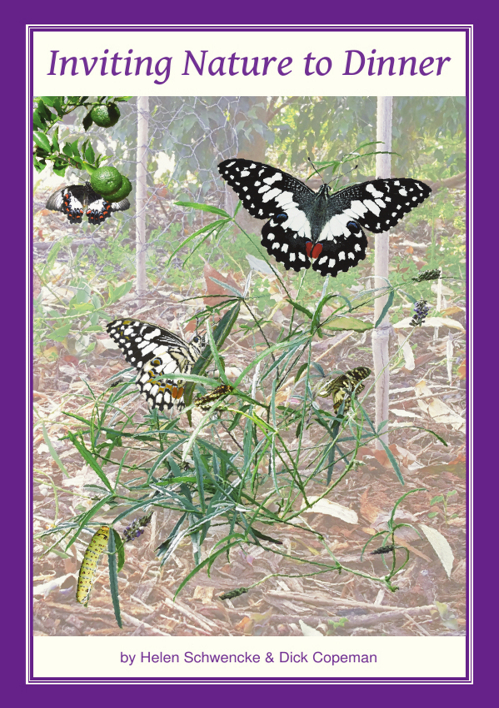The benefits of bringing biodiversity
to our backyards
by Helen Schwencke & Dick Copeman
Brisbane: Earthling Enterprises, October 2020
What people have said:
“I found it fascinating and useful”.
Prof Roger Kitching, Griffith University
“Brilliant. This book is a Trojan horse. You might think it’s a book about butterflies (and it is) but it’s really a challenge and a call to arms.”
Ron Carr, Naturalist & Bushcarer
Ordering info
- Order online
— via credit card or Paypal is available for QLD, NSW and Vic. Please email info@earthling.com.au for an invoice and details
Outside these States please use mail order.
Startrack doesn’t deliver to PO Boxes at a reasonable price for shipping.
The cost includes a 5% surcharge. - By mail order for $35 plus $13 delivery.

By Email: Please download and complete the Order Form, pay by direct deposit and email form with payment advice, the address as per the form. - Retailers:
Avid Reader, Australian Entomological Supplies, Barung Landcare, Bulimba Creek Catchment Coordinating Committee, Friends of Lismore Rainforest Botanic Gardens, Northey St City Farm, Paten Park Native Nursery, QLD Museum Shop
Preview Edition
This is a Preview edition of the book, and is complete in itself. The subject is a vast one so this edition includes a sample of what can be included in future editions.
We invite your feedback and questions, and want to know what else would be useful.
If you buy this edition and register your email address (link here) or join the Inviting Nature to Dinner Facebook page, you will be offered the expanded version, planned for late 2023, at a 25% discount.
Description
Nature is at a crisis point. Land clearing, climate change, chemicals and invasive species are decimating the living creatures with whom we share the planet. We may feel powerless to challenge these global trends, but we are not. This book shows how, by starting in our own gardens, we can begin to make a difference, amply shown by Helen’s 33-year-old butterfly and wildlife garden.
Insects comprise the great majority of all animal species and play key roles in the ecology of our world, including converting plants into food for other creatures. Many insects depend on specific plants to feed their larvae. By planting these native host plants in our gardens, we can support healthy populations of insects that will not only support the whole complex web of life but will also help protect our plants from the very small percentage of insects that can adversely affect them. An added bonus is that some of these native host plants are also edible for us.
Helen Schwencke and Dick Copeman take the reader on an exciting journey into the world of small creatures. Based on both academic and citizen science, eminently readable and beautifully illustrated, their text also provides practical advice on designing your garden and sourcing plants for it, so that you too can join them in Inviting Nature to Dinner.
Table of contents
1 Why this book? 1
Decline of insects and other invertebrates 2
Habitat destruction 3
Chemicals 3
Invasive species 5
Climate change 5
Ecological simplification 5
A role for gardeners 6
2 The diversity of life – why every species counts 7
Overview of life-forms, classification, life cycles, behaviour and ecology 8
Lifeforms on Earth – how they are classified 8
The diversity of life 10
Insect diversity 12
Insect life cycles 12
3 The ecology of growing our food 16
Plants 16
Food webs 16
Insects 18
Allies and competitors 19
Population cycles 20
Plants and insects 20
Larval and adult food plants 23
Pollination 24
Coming face-to-face with our subject 25
4 Wildlife friendly gardening 30
How to support native wildlife in your garden 30
Grow local native plants 30
Grow a diverse range of plants 31
Grow host plants for caterpillars other insect larvae 32
Grow local native flowering plants, especially those that are good nectar producers 33
Grow local native plants that are edible 34
Attract native wildlife to your vegetable garden and orchard 34
Grow plants with dense or prickly foliage 35
Grow plants that produce a lot of seed or fruit 36
Leave the old and the dead in place 37
Protect and nurture the soil 38
Provide water 39
How to plan a wildlife-friendly garden 41
Goals for the garden 41
Other considerations 41
Sketch a plan 41
Assess and analyse your site 42
Select your plants 42
Place your plants 43
5 Native food plants we can share 46
Case studies of native food plants that are also
food for butterfly larvae and other wildlife 47
Native Mulberry for Jezebel Nymph 49
Scrub caper for Caper White 51
Flame Tree for Tailed Emperor 53
Macadamia for Bright Cornelian 55
Finger Lime & Pink Limeberry for Dainty & Fuscous Swallowtail 57
Long-leaved Bolwarra for Eastern Dusk-flat 59
Slender Grape Vine for Joseph’s Coat Moth 61
Zig Zag Vine for Pale Triangle 63
Millaa Millaa Vine for Indigo Flash 65
Stinging Nettle for Yellow Admiral 67
Emu Foot for Chequered Swallowtail 69
Kangaroo Grass for Evening Brown 71
Shade Plantain for Meadow Argus 73
6 Ecological strategies to control common garden ‘pests’ 74
Lepidoptera 75
Diptera 77
Hemiptera 78
Orthoptera 80
Other Invertebrates 80
Arachnida 80
Molluscs 81
7 Building ecological complexity 82
8 Recipes for native food plants we can share 84
Macadamia, Warrigal Greens and Lemon Myrtle Pesto 84
Bunya Dooja Cake 85
9 Conclusion – What can we do? 86
Appendices 88
Appendix 1: Site assessment and analysis
Appendix 2: Some plants (mostly edible) that support butterflies and other
wildlife in south east Queensland and northern NSW
Appendix 3: Where to obtain native and bushfood plants in south east Queensland
References 100
Bibliography and Further Reading 103
About the authors 105
Index 106
